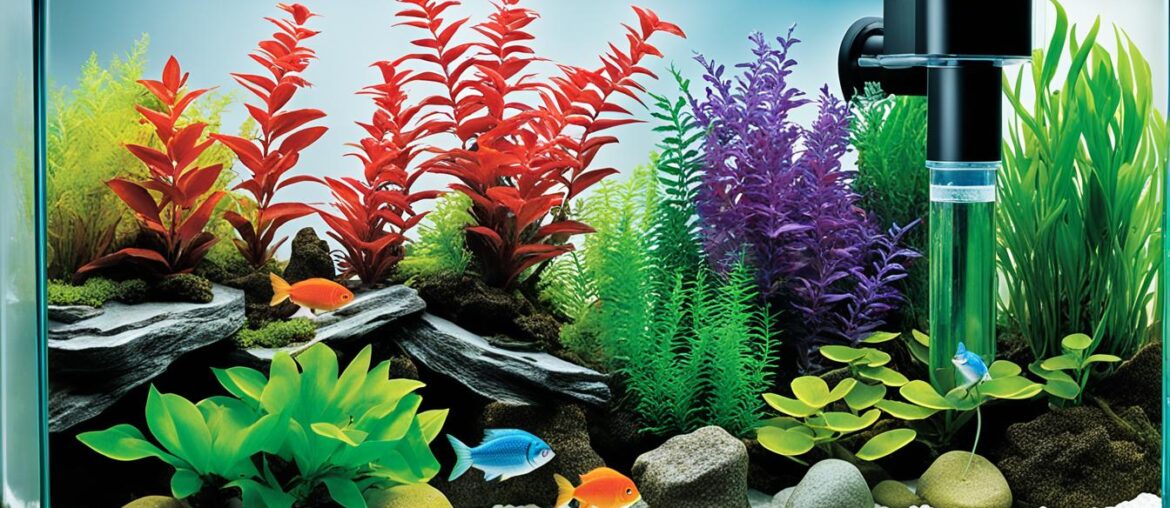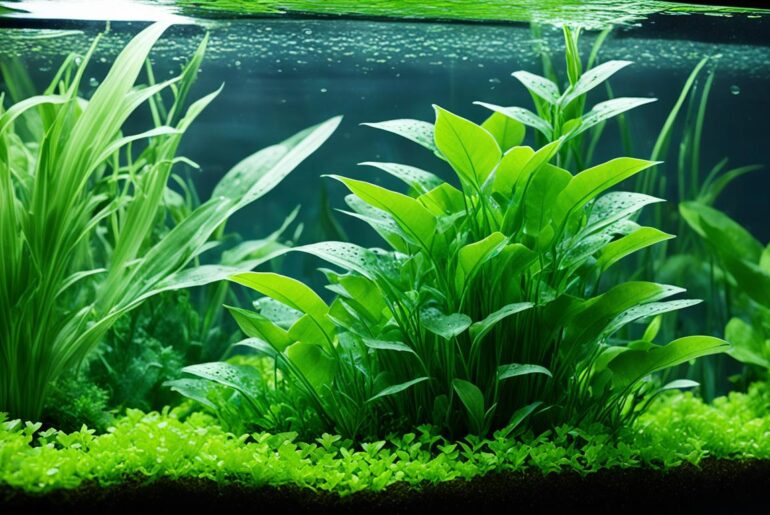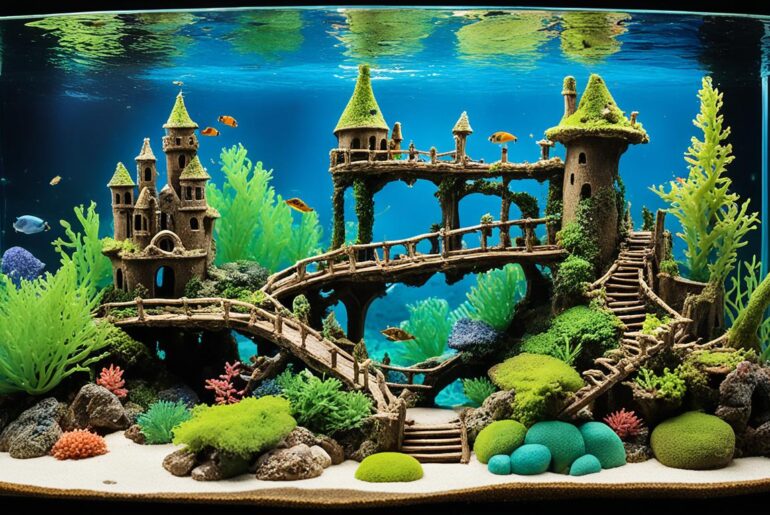Setting up a freshwater tank is an exciting endeavor. It’s like creating a whole new world right in the comfort of your own home. I remember the first time I set up my own freshwater tank. The anticipation as I carefully selected the fish, the joy of watching them swim around happily, and the sense of pride and accomplishment as I maintained a thriving aquatic ecosystem.
But to ensure the success of your freshwater tank, there are a few essential pieces of equipment that you need. These are the backbone of your tank, the tools that will provide clean water, maintain optimal conditions, and create a safe and healthy environment for your fish to thrive.
Key Takeaways:
- Setting up a freshwater tank requires essential equipment for optimal fish care and tank maintenance.
- Proper equipment ensures clean water, optimal conditions, and the overall well-being of your fish.
- The 5 essential equipment pieces for your freshwater tank are: filtration system, tank heater, lighting system, substrate, and fish tank test kits.
- Investing in quality equipment will save you time, money, and potential fish health problems in the long run.
- Remember to research the specific needs of your fish species to create the ideal habitat and ensure their well-being.
Why Choose a Freshwater Tank Over a Saltwater Tank?
When it comes to starting your aquarium journey, it’s important to make an informed decision about the type of tank you want to set up. While both freshwater and saltwater tanks offer unique beauty and opportunities for fishkeeping, there are several reasons why choosing a freshwater tank might be the better choice, especially for beginners.
1. Cost-Effectiveness
Setting up and maintaining a saltwater tank can be significantly more expensive than a freshwater tank. Saltwater tanks require specialized equipment, including protein skimmers, powerheads, and high-powered lighting systems. Additionally, maintaining the right water parameters in a saltwater tank often requires the use of supplements and additives, further increasing the expenses.
In contrast, freshwater tanks are more affordable to set up and maintain. The equipment needed for a freshwater tank, such as a filter, heater, and lighting, is generally less expensive compared to their saltwater counterparts. Moreover, maintaining the water quality in a freshwater tank is relatively easier and cost-effective.
2. Easier Maintenance
One of the main advantages of freshwater tanks is their ease of maintenance. Freshwater fish are generally hardier and more adaptable to a range of water conditions. They are less sensitive to changes in water chemistry and temperature, making it easier for beginners to maintain a stable and healthy environment.
In contrast, saltwater tanks require meticulous attention to detail and frequent monitoring of water parameters. Saltwater fish and invertebrates are often more sensitive to changes in salinity, temperature, and water quality, necessitating frequent water testing and adjustments. Maintaining proper salinity levels can be challenging, especially for beginners.
3. Wide Range of Fish Options
Freshwater tanks offer a vast array of fish species to choose from. From vibrant tropical fish like guppies and tetras to stunning cichlids and bettas, there is a diverse selection of freshwater fish that can thrive in a well-maintained tank.
While saltwater tanks do offer equally stunning and colorful fish options, they are often more demanding in terms of habitat requirements and compatibility. Many saltwater fish require large tanks with intricate reef systems, which may not be feasible for beginners or hobbyists with limited space or resources.
4. Beginner-Friendly
For those new to the world of fishkeeping, freshwater tanks provide a more forgiving and beginner-friendly experience. The hardiness of freshwater fish, along with the ease of maintaining water quality, allows beginners to learn and adapt to the hobby without feeling overwhelmed.
Additionally, the availability of comprehensive resources, experienced hobbyists, and knowledgeable staff at local fish stores make it easier for beginners to seek advice and guidance specifically tailored to their freshwater tank needs.
Overall, freshwater tanks are an excellent choice for beginners due to their cost-effectiveness, easier maintenance, wide range of fish options, and beginner-friendly nature. As you gain experience and confidence in fishkeeping, you can always explore the world of saltwater tanks at a later stage if you desire.
| Reasons | Freshwater Tanks | Saltwater Tanks |
|---|---|---|
| Cost-Effectiveness | Less expensive to set up and maintain | Expensive equipment and additional supplements |
| Ease of Maintenance | Hardier fish, less sensitive to water changes | Require meticulous monitoring and adjustment of water parameters |
| Wide Range of Fish Options | Diverse selection of freshwater fish species | Require large tanks with intricate reef systems |
| Beginner-Friendly | Forgiving experience, availability of resources and guidance | More demanding for beginners, limited resources |
With all these advantages, choosing a freshwater tank is an excellent way to embark on your fishkeeping journey. The affordability, ease of maintenance, wide range of fish options, and beginner-friendly nature make freshwater tanks a fantastic choice for both novices and experienced hobbyists alike.
Choosing the Right Fish Tank Size and Material
When setting up a freshwater tank, one of the crucial decisions you need to make is choosing the right size and material for your fish tank. The size of the tank plays a significant role in providing enough space for your fish to swim and thrive, while the material determines the tank’s durability and aesthetic appeal.
Glass vs. Acrylic Tanks
Two common options for fish tank materials are glass and acrylic. Glass tanks are known for their scratch-resistant nature and excellent visibility, allowing you to enjoy a clear view of your underwater world. However, they can be quite heavy, making them more challenging to move or transport.
On the other hand, acrylic tanks are lightweight and more durable than their glass counterparts. They are less prone to cracking or shattering, which is especially beneficial if you have active fish or live in an earthquake-prone area. However, acrylic tanks are more susceptible to scratching and may require extra care when cleaning.
Tank Size for Freshwater Fish
The size of your fish tank is crucial for providing a suitable living space for your freshwater fish. Fish need ample space to swim and explore, and overcrowding can lead to stress, aggressive behavior, and poor water quality. It is generally recommended to choose a tank size that offers enough room for your fish species to grow and exhibit their natural behavior.
For most freshwater fish:
- A tank size of at least 16 gallons is considered suitable for small to medium-sized freshwater fish.
- For betta fish, a minimum tank size of 5 gallons is recommended to provide enough swimming space and ensure their well-being.
Investing in an Aquarium Stand and Fish Tank Lid
When setting up your freshwater tank, it is essential to invest in an appropriate aquarium stand to provide stability and support for your tank’s weight. A sturdy stand ensures that your tank is secure and reduces the risk of accidents or damage.
Additionally, a fish tank lid is a vital accessory that helps keep your fish safe and secure. It prevents fish from jumping out of the tank and minimizes evaporation. A lid also aids in maintaining stable water conditions by preventing dust, debris, or pets from coming into contact with the water.
By carefully considering the size and material of your fish tank and investing in a suitable stand and lid, you can create a safe and comfortable environment for your freshwater fish to thrive.
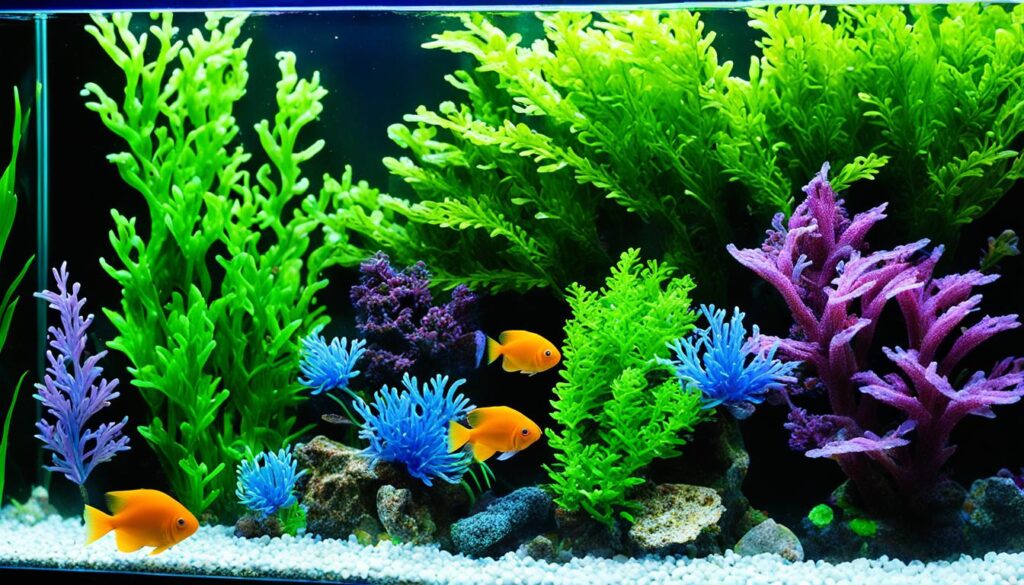
Essential Filtration for a Healthy Aquarium
A high-quality aquarium filter is crucial for maintaining water quality in your freshwater tank. Filters play a vital role in providing mechanical, chemical, and biological filtration, ensuring a clean and healthy environment for your fish.
Aquarium Filter Types
There are several types of aquarium filters available, each with its own advantages and suitable for different tank sizes:
- Canister Filters: Best for larger tanks, canister filters offer high filtration capacity and can accommodate various filter media.
- Hang-On Filters: Ideal for smaller tanks, hang-on filters provide efficient filtration while taking up minimal space.
- Sponge Filters: Suitable for both small and large tanks, sponge filters are excellent for biological filtration and are easy to maintain.
Mechanical Filtration
Mechanical filtration is the first line of defense in removing debris and particles from the aquarium water. It helps to keep the water clear and prevents clogging in the filter media. The filter traps larger particles, such as uneaten food and fish waste, preventing them from decomposing and polluting the water.
Chemical Filtration
Chemical filtration involves the use of filter media, such as activated carbon, to remove impurities and contaminants from the water. Activated carbon absorbs dissolved organic compounds, odors, and discoloration, helping to improve water clarity and quality.
Biological Filtration
Biological filtration is essential for establishing and maintaining a healthy aquarium ecosystem. Beneficial bacteria colonize the filter media and convert harmful ammonia, produced by fish waste and decaying organic matter, into less toxic nitrite and then into nitrate. Nitrate can be removed through regular water changes.
Having a combination of mechanical, chemical, and biological filtration ensures that your aquarium water is free from visible debris, harmful substances, and maintains a stable nitrogen cycle.
To determine the best filter for your freshwater tank, consider the size of your tank and the specific needs of your fish species. Larger tanks may benefit from canister filters, while smaller tanks can be adequately maintained with hang-on or sponge filters.
| Aquarium Filter Type | Recommended Tank Size | Filtration Capacity |
|---|---|---|
| Canister Filters | Larger tanks | High |
| Hang-On Filters | Smaller tanks | Efficient |
| Sponge Filters | Small and large tanks | Biological |
By selecting the appropriate filter for your freshwater tank, you can ensure that the water remains clean, clear, and conducive to the health and well-being of your beloved aquatic pets.
Importance of Substrate in Freshwater Tanks
When it comes to setting up a freshwater tank, choosing the right substrate is crucial for maintaining a healthy and thriving aquatic environment. Not only does fish tank substrate enhance the aesthetic appeal of the aquarium, but it also serves a functional role in promoting the overall well-being of your fish and other aquatic organisms.
Substrate, such as aquarium gravel or bioactive substrate, provides a surface for beneficial bacteria to grow. These bacteria play a vital role in the nitrogen cycle, converting harmful ammonia into nitrate and creating a stable and biologically balanced environment. By establishing a colony of beneficial bacteria, the substrate helps maintain optimal water conditions and reduces the risk of ammonia spikes that can be detrimental to fish health.
In addition to supporting the growth of beneficial bacteria, substrate is an essential component for planted aquariums. Planted aquarium substrate not only anchors the roots of aquatic plants but also provides a source of nutrients for their growth. This type of substrate is often enriched with essential nutrients, such as nitrogen, phosphorus, and potassium, which are vital for the healthy development of aquatic plants. With a well-chosen planted aquarium substrate, you can create a lush and vibrant aquatic landscape that enhances the natural beauty of your freshwater tank.
There are several options available when it comes to choosing the right substrate for your freshwater tank. One popular choice is polished gravel, which comes in a variety of colors and sizes, allowing you to create a customized and visually appealing aquarium. Another option is bioactive substrate, which consists of a combination of minerals, organic matter, and beneficial microorganisms. This type of substrate not only provides a natural habitat for beneficial bacteria but also contributes to the overall biological filtration of the tank.
When selecting substrate for your freshwater tank, it’s important to consider the specific needs of your fish species and aquarium setup. Some fish species prefer sandy substrates, while others may thrive in gravel or planted aquarium substrate. Researching the requirements of your fish species will help you choose the most suitable substrate option for their well-being.
“Proper substrate selection is essential for creating a healthy and thriving freshwater tank.”
In summary, the substrate in your freshwater tank is more than just decorative material; it plays a crucial role in maintaining water quality, supporting beneficial bacteria, and promoting the growth of aquatic plants. By choosing the right substrate, such as aquarium gravel or bioactive substrate, you can create an optimal environment for your fish and enjoy a visually stunning aquatic landscape.
Comparing Substrate Options
| Substrate Option | Benefits |
|---|---|
| Aquarium Gravel | – Provides a variety of colors and sizes for aesthetic customization. – Supports beneficial bacteria growth. – Suitable for a wide range of fish species. |
| Bioactive Substrate | – Contains minerals, organic matter, and beneficial microorganisms for enhanced biological filtration. – Provides a natural habitat for beneficial bacteria. – Supports the growth of aquatic plants. |
| Planted Aquarium Substrate | – Enriched with essential nutrients for healthy plant growth. – Anchors plant roots and provides a source of nutrients. – Creates a lush and vibrant aquatic landscape. |
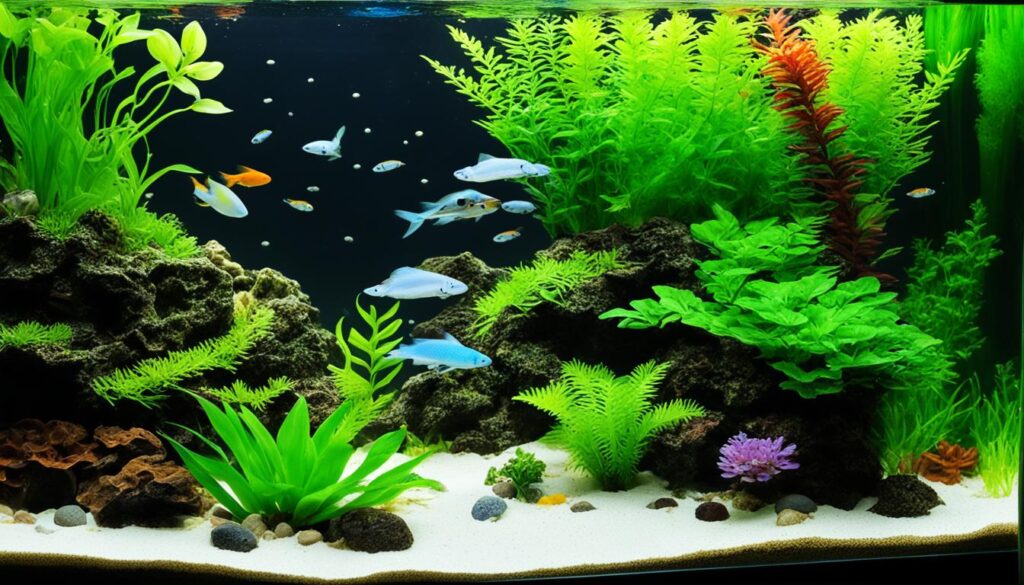
Choosing the Right Aquarium Lighting
Proper lighting is essential for both the aesthetics and health of your freshwater tank. When it comes to aquarium lighting options, there are several choices to consider, including incandescent lights, fluorescent lights, metal halide lights, and LED lights.
Incandescent lights were once popular for aquariums due to their affordability and warm lighting. However, they are not ideal for maintaining a healthy environment for your fish and plants, as they produce a lot of heat and have a relatively short lifespan.
Fluorescent lights offer a more energy-efficient option with a longer lifespan compared to incandescent lights. They provide adequate lighting for most freshwater aquariums and come in various sizes and colors. However, fluorescent lights may not be suitable for tanks with live plants that require higher light intensity.
When it comes to modern aquarium lighting, LED lights have become the preferred choice for many fish keepers. LED lights are highly energy-efficient, consuming less power while producing brighter and more focused light. They also emit less heat, reducing the risk of overheating your tank. Moreover, LED lights can be customized to replicate natural daylight conditions, which promotes the growth of aquatic plants and enhances the colors of your fish.
“LED lights have become the go-to option for aquarium lighting due to their longevity, energy efficiency, and ability to promote plant growth.”
LED lights offer various benefits for fish tanks:
- Longevity: LED lights have an impressive lifespan, lasting up to 50,000 hours or more. This means fewer bulb replacements and reduced costs in the long run.
- Energy Efficiency: LED lights consume significantly less energy compared to traditional lighting options, helping you save on electricity bills while reducing your carbon footprint.
- Plant Growth: LED lights can provide the specific light spectrum needed for photosynthesis, promoting healthy plant growth in your aquarium.
- Color Enhancement: LED lights can enhance the natural colors of your fish, making them appear more vibrant and visually appealing.
- Customizability: Many LED lighting systems allow you to adjust the intensity, color, and even simulate natural sunrise and sunset effects, creating a more natural and visually appealing environment.
When choosing the right lighting option for your freshwater tank, consider the specific needs of your tank inhabitants and your budget. LED lights may seem more expensive initially, but their long lifespan and energy efficiency make them a cost-effective investment in the long run.
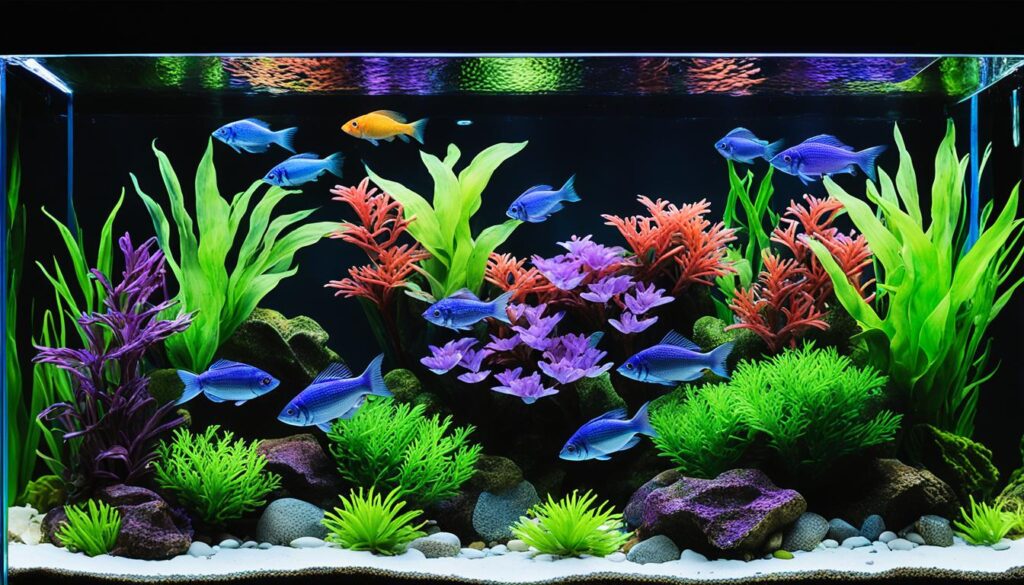
| Aquarium Lighting Option | Advantages |
|---|---|
| Incandescent Lights | – Affordability – Warm lighting |
| Fluorescent Lights | – Energy-efficient – Longer lifespan – Available in various sizes and colors |
| LED Lights | – Long lifespan – Energy-efficient – Promote plant growth – Enhance fish colors – Customizable |
Maintaining the Right Temperature with an Aquarium Heater
When it comes to keeping freshwater fish, maintaining a stable water temperature is crucial for their health and well-being. Most tropical fish species thrive in temperatures ranging from 75 to 79 degrees Fahrenheit. To achieve and maintain this optimal temperature, an aquarium heater is essential.
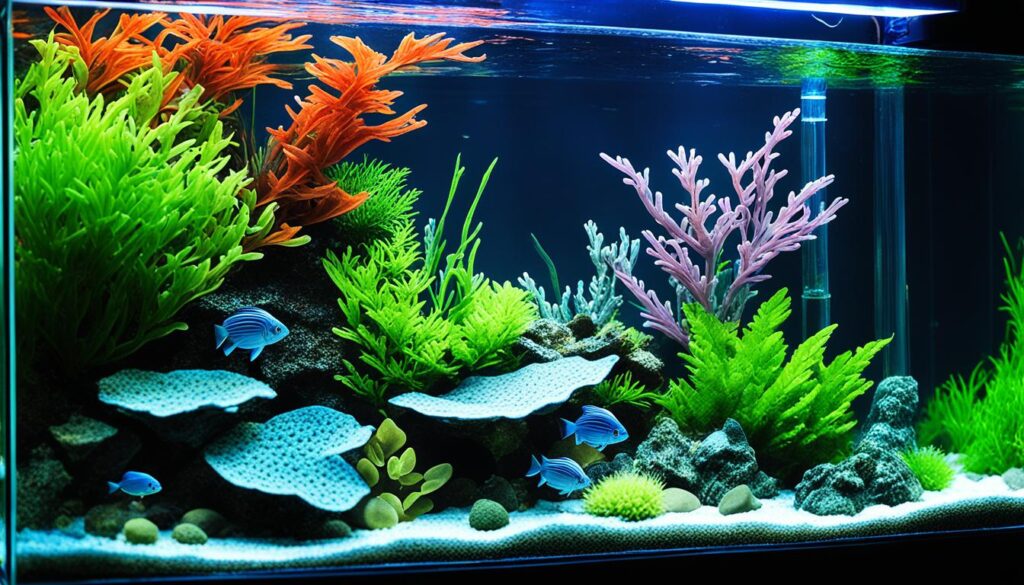
There are different types of aquarium heaters available, each with its own advantages and considerations:
| Type | Description | Pros | Cons |
|---|---|---|---|
| Hanging Heaters | Hang-on-back heaters that attach to the edge of the tank. |
|
|
| Immersion Heaters | Submersible heaters that sit directly in the water. |
|
|
| In-line Heaters | Installed in the water filtration system, usually in the outflow tubing. |
|
|
Choosing the right size heater is equally important to ensure effective temperature regulation in your aquarium. A heater that is too small may struggle to maintain the desired temperature, while a heater that is too large can overheat the water. It is recommended to select a heater based on the size of your tank and follow the manufacturer’s guidelines for optimal temperature control.
Remember that a reliable thermometer is essential for accurately monitoring the water temperature. Regularly check the temperature to ensure it remains within the appropriate range.
Quote:
“A stable and appropriate water temperature is a key factor for the well-being of tropical fish.” – Marine Aquarium Experts
By choosing the right type and size of aquarium heater, you can ensure a comfortable and healthy environment for your freshwater fish, promoting their overall well-being and longevity.
The Role of Air Pump in Freshwater Tanks
While not always necessary, an air pump can be a beneficial addition to your freshwater tank. It aids in water oxygenation and promotes even distribution of heat throughout the tank. If your tank already has adequate water circulation from filters or sponge filters, an air pump may not be necessary.
An aquarium air pump is a device that uses an electric motor to generate a continuous flow of air. By pumping air into the tank, it increases the oxygen levels in the water, which is vital for the health and well-being of your fish.
One of the primary benefits of using an air pump is water oxygenation. Fish require oxygen to survive, and a well-oxygenated tank ensures their respiratory needs are met. Additionally, air pumps can help to circulate the water in your tank, preventing stagnant areas and encouraging better nutrient distribution.
Another advantage of using an air pump is the promotion of even heat distribution throughout the tank. By producing small air bubbles, the air pump creates surface agitation, which helps to break the surface tension of the water. This agitation allows for better gas exchange and heat distribution, ensuring a more stable and comfortable environment for your fish.
When considering whether to use an air pump in your freshwater tank, it is essential to assess the existing water circulation. If your tank already has effective filtration systems or sponge filters that provide sufficient water movement and oxygenation, an air pump may not be necessary. However, if you notice any areas with limited water flow or insufficient oxygen levels, an air pump can significantly improve the overall health and vitality of your aquarium.
Remember to choose the right size air pump for your tank’s needs, taking into account the water volume and the desired air flow rate. Follow the manufacturer’s instructions for installation and consider using air stones or diffusers for more efficient air distribution.
In conclusion, while not essential for every freshwater tank, an air pump can play a crucial role in maintaining optimal water oxygenation, water circulation, and heat distribution. Assess the needs of your specific tank and fish to determine if adding an air pump will provide significant benefits.
Essential Tools for Fish Tank Maintenance
Regular maintenance is vital for the health and cleanliness of your freshwater tank. To keep your aquarium in optimal condition, it’s important to have the right tools at hand. Here are five essential tools every fish tank owner should have:
Siphon Gravel Vacuum
A siphon gravel vacuum is an indispensable tool for water changes and debris removal in your fish tank. This device makes it easy to clean the substrate, removing uneaten food, waste, and other detritus that can accumulate at the bottom of the tank. By removing these materials, you can maintain a clean and healthy environment for your fish.
Algae Scraper
Keeping the glass of your fish tank clean is essential for maintaining visibility and preventing the buildup of algae. An algae scraper is a specialized tool designed to remove algae and other undesirable substances from the glass surface. Regular use of an algae scraper will help keep your aquarium looking pristine.
Water Bucket
When performing water changes, a water bucket is a convenient tool for transporting water in and out of your fish tank. Make sure to dedicate a bucket solely for aquarium use to avoid the risk of cross-contamination from cleaning agents or residues. Use the bucket to remove old water during water changes and add new conditioned water to maintain proper water parameters.
Water Conditioner
Tap water may contain chemicals, such as chlorine or chloramine, that are harmful to fish. Before adding tap water to your tank, it’s crucial to treat it with a water conditioner to neutralize these harmful compounds. Water conditioners also help to detoxify heavy metals and provide essential electrolytes to promote fish health.
Fish Tank Test Kits
To ensure the water parameters in your fish tank are within the appropriate range, it’s essential to regularly monitor key levels such as ammonia, nitrite, nitrate, pH, and carbonate hardness. Fish tank test kits are specifically designed to provide accurate readings for these parameters, allowing you to take necessary actions to maintain a stable and healthy environment for your fish.
Having these essential tools readily available will make maintaining your freshwater tank easier and more efficient. Regular maintenance, including water changes, substrate cleaning, and glass cleaning, will help keep your fish happy and your aquarium thriving.
| Tool | Description |
|---|---|
| Siphon Gravel Vacuum | A tool used for water changes and debris removal in the tank’s substrate. |
| Algae Scraper | A specialized tool for removing algae and other unwanted substances from the tank’s glass surface. |
| Water Bucket | A container dedicated to transporting water during water changes and maintenance tasks. |
| Water Conditioner | A treatment added to tap water to remove harmful chemicals and provide essential electrolytes. |
| Fish Tank Test Kits | Kits used to monitor water parameters, such as ammonia, nitrite, nitrate, pH, and carbonate hardness. |
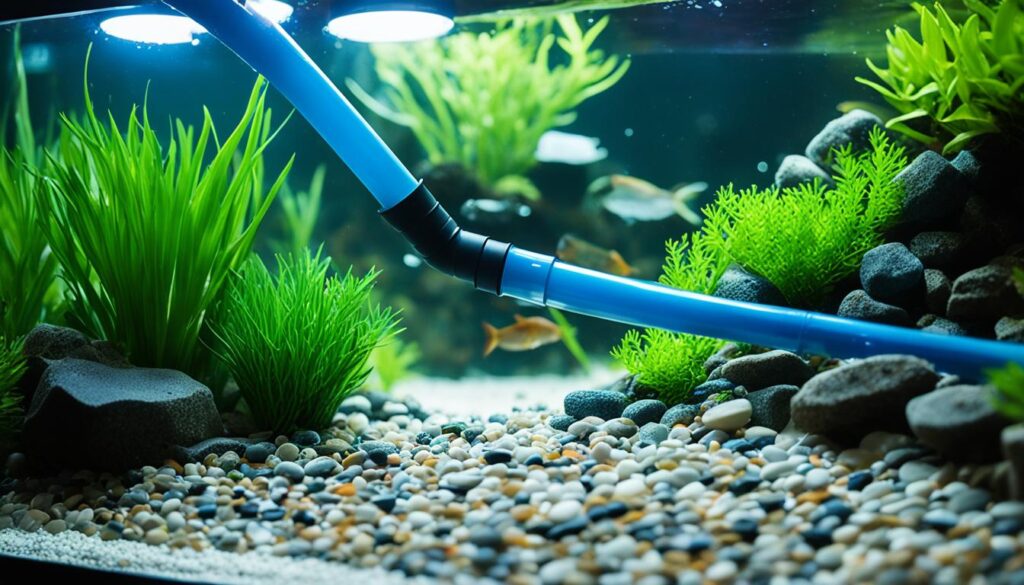
Creating the Ideal Habitat for Your Fish
When setting up a freshwater tank, it is essential to consider the preferences and requirements of the fish species you intend to keep. Researching the indigenous habitat, ideal water parameters, feeding habits, and social compatibility of your chosen fish will help you create an ideal aquarium habitat.
Fish species compatibility: Each fish species has specific habitat requirements and social behaviors. It is important to choose fish that coexist peacefully and prefer similar water conditions. Avoid pairing aggressive and peaceful fish together to maintain a harmonious tank environment.
Research fish species: Before adding fish to your tank, research their natural habitat and behavior. This information will guide you in selecting compatible fish and creating a suitable environment. Study their preferred temperature range, pH level, water hardness, and any specific habitat structures they need.
Aquarium habitat: Mimicking the natural habitat of your fish species is crucial for their well-being. Provide hiding places, caves, and structures that resemble their native environment. This will make your fish feel secure and provide them with a sense of familiar territory.
Aquarium decorations: Choose appropriate aquarium decorations that complement the needs of your fish species. Driftwood, rocks, and caves can serve as hiding spots, while artificial or live plants provide cover and oxygenation. Ensure that any decorations you choose are safe for freshwater tanks and do not leach harmful substances into the water.
Aquarium plants: Live plants offer numerous benefits in a freshwater tank. They oxygenate the water, absorb harmful toxins, and provide natural beauty. Research and select aquarium plants that are compatible with your fish species and create a balanced ecosystem.
“Creating a habitat that closely resembles the fish species’ natural environment promotes their overall well-being and enhances their natural behaviors.”
By investing time in understanding your fish species and their habitat requirements, you can create a thriving and visually appealing freshwater tank. Providing a suitable habitat will contribute to the health and happiness of your fish, creating an enjoyable and rewarding aquarium experience.

Conclusion
In conclusion, creating a healthy and thriving freshwater aquarium requires essential equipment and careful consideration of various factors. By selecting the right tank size and material, ensuring proper filtration, lighting, and temperature control, and maintaining water quality, you can provide an optimal environment for your freshwater fish.
Researching the specific needs of your chosen fish species is crucial in creating a habitat that mimics their natural environment. Adding suitable decorations and plants not only enhances the aesthetic appeal of the tank but also provides hiding places and stimulation for your fish.
Remember, setting up a freshwater tank is an ongoing journey of discovery and care. Regular maintenance, such as water changes, debris removal, and monitoring water parameters, is vital for the health and longevity of your aquarium. Enjoy the rewarding experience of observing and caring for your fish as you create a beautiful and thriving aquatic habitat.
FAQ
What are the essential equipment pieces for freshwater tanks?
The essential equipment pieces for freshwater tanks include a tank of appropriate size and material, aquarium filter, fish tank substrate, proper lighting, aquarium heater, optional air pump, and essential tools for maintenance.
Why should I choose a freshwater tank over a saltwater tank?
Freshwater tanks are generally more affordable and easier to maintain compared to saltwater tanks. They require less specialized equipment, lower maintenance costs, and have a wider range of suitable fish species for beginners.
How do I choose the right tank size and material for a freshwater tank?
It is recommended to choose a tank size of at least 16 gallons for freshwater fish, with a minimum of 5 gallons for betta fish. Glass tanks provide better visibility but can be heavy, while acrylic tanks are more durable but prone to scratching. Additionally, invest in a sturdy aquarium stand and a lid for safety.
What is the importance of filtration in a freshwater tank?
Filtration is crucial for maintaining water quality in a freshwater tank. It removes debris, toxins, and promotes a healthy environment for fish. The ideal filter type will depend on the size of your tank, with canister filters recommended for larger tanks and hang-on or sponge filters suitable for smaller tanks.
Why is substrate important in freshwater tanks?
Substrate provides a surface for beneficial bacteria to grow and supports the growth of aquarium plants. Popular options include polished gravel and bioactive substrates, which offer both decorative appeal and a habitat for beneficial microorganisms.
How do I choose the right aquarium lighting for my freshwater tank?
LED lights are recommended for their longevity, energy efficiency, and ability to promote plant growth. Consider the specific needs of your tank and budget when choosing the right lighting option.
How do I maintain the right temperature in my freshwater tank?
Most tropical fish require a temperature range of 75-79 degrees Fahrenheit. Different types of aquarium heaters are available, including hanging, immersion, and in-line heaters. Choose the right size heater based on your tank size and follow manufacturer recommendations.
Is an air pump necessary for a freshwater tank?
While not always necessary, an air pump can aid in water oxygenation and promote even distribution of heat throughout the tank. If your tank already has adequate water circulation from filters or sponge filters, an air pump may not be necessary.
What are the essential tools for fish tank maintenance?
Essential tools for fish tank maintenance include a siphon gravel vacuum for water changes and debris removal, an algae scraper for cleaning the glass, a water bucket for water changes, water conditioner to remove harmful chemicals from tap water, and fish tank test kits for monitoring water parameters.
How do I create the ideal habitat for my fish in a freshwater tank?
Research the preferences and requirements of the fish species you intend to keep. Mimic their natural environment with appropriate aquarium decorations and plants, providing hiding places and stimulation.
What is the conclusion regarding essential equipment for freshwater tanks?
Setting up a freshwater tank requires a few essential pieces of equipment to ensure a healthy and vibrant aquarium. By choosing the right tank size, filtration system, lighting, and maintaining proper temperature and water quality, you can create an optimal environment for your freshwater fish.
